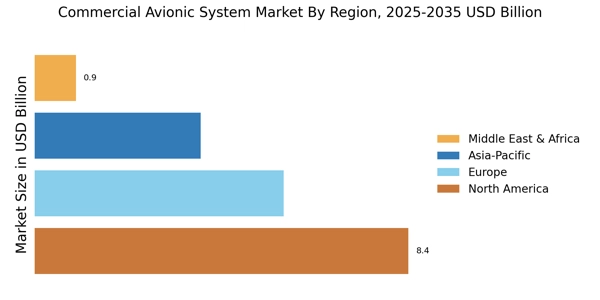Focus on Fuel Efficiency
The Commercial Avionic System Market is increasingly focusing on fuel efficiency as airlines strive to reduce operational costs and minimize their environmental impact. The integration of advanced avionics systems plays a crucial role in optimizing fuel consumption through improved flight planning and real-time data analytics. Airlines are investing in technologies that enable more efficient routing and altitude management, which can lead to significant fuel savings. According to industry reports, fuel costs account for a substantial portion of airline operating expenses, making fuel-efficient avionic systems a priority for many operators. As the aviation sector continues to emphasize sustainability, the demand for avionics that contribute to fuel efficiency is expected to rise, thereby driving innovation and investment in this area.
Rising Demand for Air Travel
The Commercial Avionic System Market is poised for growth due to the rising demand for air travel across various regions. As economies expand and disposable incomes increase, more individuals are opting for air travel, leading to a surge in airline operations. This heightened demand necessitates the modernization of existing aircraft and the acquisition of new ones, which in turn drives the need for advanced avionic systems. Recent projections suggest that the number of commercial aircraft in operation will increase significantly over the next decade, with estimates indicating a need for over 40,000 new aircraft by 2030. Consequently, the demand for sophisticated avionic systems that enhance operational efficiency and passenger safety is likely to escalate, positioning the avionic market for substantial growth in the coming years.
Technological Advancements in Avionics
The Commercial Avionic System Market is experiencing a surge in technological advancements, particularly in the areas of automation and digitalization. Innovations such as fly-by-wire systems and advanced navigation technologies are enhancing aircraft performance and safety. The integration of cutting-edge technologies, including artificial intelligence and machine learning, is streamlining operations and improving decision-making processes. According to recent data, the avionics market is projected to grow at a compound annual growth rate of approximately 5.5% over the next five years. This growth is driven by the increasing demand for modernized aircraft systems that can support complex flight operations and enhance passenger experience. As airlines seek to optimize their fleets, the adoption of advanced avionics systems is likely to become a critical factor in maintaining competitive advantage.
Regulatory Compliance and Safety Standards
The Commercial Avionic System Market is significantly influenced by stringent regulatory compliance and safety standards imposed by aviation authorities. These regulations are designed to ensure the safety and reliability of aircraft systems, which in turn drives the demand for advanced avionic solutions. Manufacturers are compelled to innovate and upgrade their systems to meet these evolving standards, which often leads to increased investment in research and development. The market is expected to witness a steady growth trajectory as airlines and manufacturers prioritize compliance with safety regulations. Recent statistics indicate that The Commercial Avionic System Market is projected to reach USD 10 billion by 2026, underscoring the importance of regulatory adherence in shaping the avionic landscape. This trend emphasizes the necessity for continuous improvement in avionic technologies to align with safety mandates.
Emergence of Unmanned Aerial Vehicles (UAVs)
The Commercial Avionic System Market is witnessing a transformative shift with the emergence of unmanned aerial vehicles (UAVs). The increasing adoption of UAVs for various applications, including cargo transport, surveillance, and agricultural monitoring, is creating new opportunities for avionic system manufacturers. These systems require specialized avionics that can support autonomous operations and ensure safety during flight. The UAV market is projected to grow exponentially, with estimates suggesting a compound annual growth rate of over 15% in the coming years. This growth is likely to drive demand for innovative avionic solutions tailored to the unique requirements of UAVs. As the boundaries of aviation expand, the integration of advanced avionic systems into UAVs will be essential for their successful deployment and operation.


















Leave a Comment